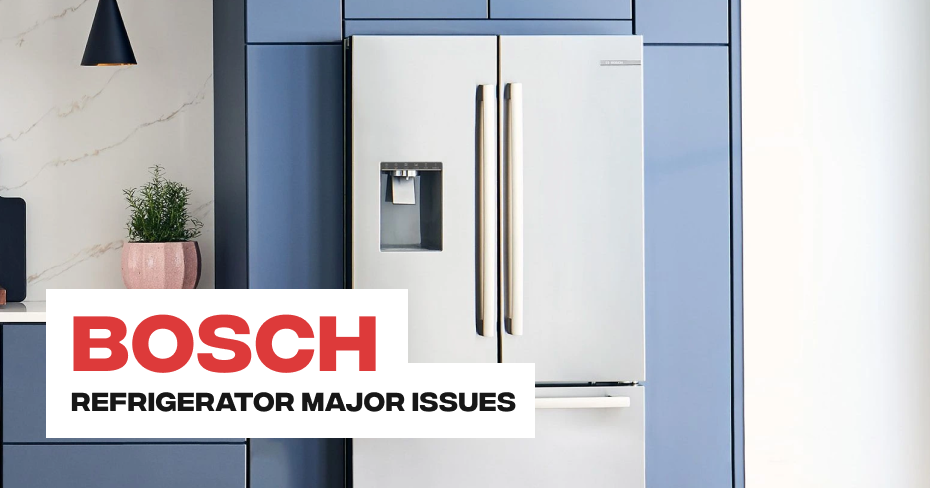
Bosch Refrigerator Water Leaks
Bosch manufactures a range of quality home appliances, including refrigerators, dishwashers, and stovetops.
But even the best products sometimes need repairs, and Bosch appliances are no different.
One of the most common problems with a refrigerator is when it starts leaking.
To help you out, we have put together this comprehensive guide that covers the most common causes of water leaking from your refrigerator and how you can fix them.
Check Your Defrost Drain
Your Bosch refrigerator has a defrost drain, which can sometimes freeze, causing water to overflow and leak. To ensure the defrost drain is not causing the leak, you need to:
- Turn your refrigerator off at the wall.
- Locate the defrost drain. You can find it at the back of the refrigerator near the bottom. You’ll have to remove the lower back panel in order to access it.
- Once you have located it, check the drain to see if it is frozen or clogged up with any debris.
- If you find that it is clogged up, remove any debris that you can find, and then flush some hot water through the drain to clear out the rest of the debris that is clogging it up.
- If the drain is frozen, you need to remove the ice – which will naturally happen if you have the refrigerator turned off.
- Once you have carried out a thorough cleaning or let the ice thaw, you can plug your refrigerator back in. Once it has operated for a few hours, you should be able to see if this has fixed the leak.
Inspect the Water Filter Head
Another component to check is the water filter head. The water filter head in your Bosch refrigerator can sometimes get cracked, or the seal might be faulty. Here’s how to check it:
- Locate the water filter – it is usually located within the fridge.
- Check that the housing around the water filter doesn’t contain any cracks.
- If it does contain cracks, you will have to replace the filter housing.
Inspect the Water Filter
If the problem is not the water filter head, it could be the water filter itself. Here’s what you need to do:
- Check that the water filter is fitted properly on the filter housing and that there are no visible leaks.
- Remove the water filter from the filter housing, and then put it back in to see if it fits properly.
- If the water filter doesn’t fit correctly, it will need to be replaced along with possibly the filter housing. Please note that the water filter should be replaced on a regular basis as per the Bosch refrigerator manual for your specific model.
Check the Water Inlet Valve
The water inlet valve is another possible cause of your leak problem. This component opens up to let water into the dispenser and icemaker. To check if it is in good condition, you need to:
- Turn your refrigerator off at the wall.
- Find the water inlet value – you should be able to find it at the lower part of the back of the fridge (you might have to remove the back panel to get to it).
- Check that the water valve is tightly secured to the water supply line/pipe and that there is no crack in the valve. If there is a leak coming from the valve, you should be able to see it in most cases unless it is a very small leak.
- If you do find a leak, you’ll need to replace the water inlet valve.
Check the Water Tank
Another cause of the leak could be a hole in the water tank. To find out you’ll need to:
- Turn the refrigerator off at the wall, and turn the water supply off.
- Locate the water tank – it is usually in the wall of the fridge behind panels. Remove the panels so that you have access to it.
- Once you have access to it, check that there are no cracks in the tank that are causing leaks to occur.
- If you do find a leak, you’ll need to replace the tank, as most glues will not be strong enough to fix a leak.
Check the Drain Pan
If your Bosch dishwasher is a self-defrosting model, it will have a drain pan that collects water when it melts from the evaporator coils. The water in the drain pan evaporates by the condenser fan blowing warm air from the coils across the top of the drain pan, which removes it. This means you don’t have to manually empty the pan. The problem is that sometimes the pan gets a crack in it, which causes a leak when the defrost cycle is running. To check the drain pan:
- Turn the refrigerator off at the wall.
- Locate the drain pan – you’ll find it at the very bottom of the fridge at the back. You may need to remove the back panel to get proper access to it – especially if you need to replace it.
- Check the drain pan for any cracks.
- If you find any cracks, the drain pan will need to be replaced.
